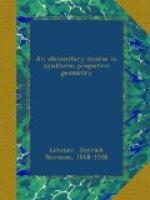9. Projective relation. It is easy to imagine a more general correspondence between the points of two point-rows than the one just described. If we take two perspective pencils, A and S, then a point-row a perspective to A will be in one-to-one correspondence with a point-row b perspective to B, but corresponding points will not, in general, lie on lines which all pass through a point. Two such point-rows are said to be projectively related, or simply projective to each other. Similarly, two pencils of rays, or of planes, are projectively related to each other if they are perspective to two perspective point-rows. This idea will be generalized later on. It is important to note that between the elements of two projective fundamental forms there is a one-to-one correspondence, and also that this correspondence is in general continuous; that is, by taking two elements of one form sufficiently close to each other, the two corresponding elements in the other form may be made to approach each other arbitrarily close. In the case of point-rows this continuity is subject to exception in the neighborhood of the point “at infinity.”
10. Infinity-to-one correspondence. It might be inferred that any infinite assemblage could be put into one-to-one correspondence with any other. Such is not the case, however, if the correspondence is to be continuous, between the points on a line and the points on a plane. Consider two lines which lie in different planes, and take m points on one and n points on the other. The number of lines joining the m points of one to the n points jof the other is clearly mn. If we symbolize the totality of points on a line by [infinity], then a reasonable symbol for the totality of lines drawn to cut two lines would be [infinity]2. Clearly, for every point on one line there are [infinity] lines cutting across the other, so that the correspondence might be called [infinity]-to-one. Thus the assemblage of lines cutting across two lines is of higher order than the assemblage of points on a line; and as we have called the point-row an assemblage of the first order, the system of lines cutting across two lines ought to be called of the second order.
11. Infinitudes of different orders. Now it is easy to set up a one-to-one correspondence between the points in a plane and the system of lines cutting across two lines which lie in different planes. In fact, each line of the system of lines meets the plane in one point, and each point in the plane determines one and only one line cutting across the two given lines—namely, the line of intersection of the two planes determined by the given point with each of the given lines. The assemblage of points in the plane is thus of the same order as that of the lines cutting across two lines which lie in different planes, and ought therefore to be spoken of as of the second order. We express all these results as follows:




